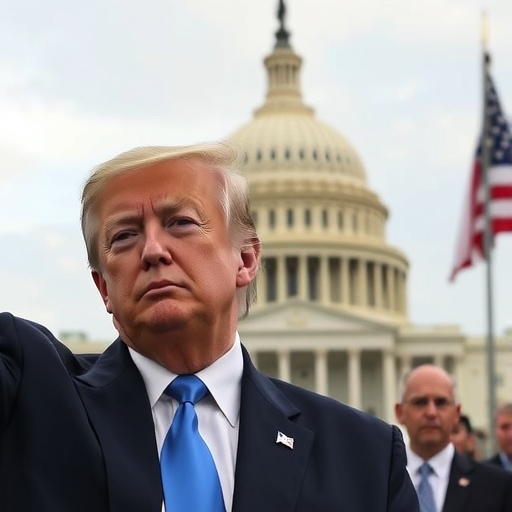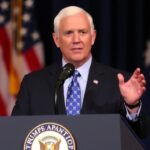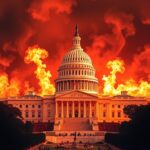In a escalating clash that threatens the foundations of American democracy, the ongoing US Government shutdown has ignited a fierce power struggle between President Donald Trump and Congress, with billions in federal spending frozen and constitutional lines blurring. As the shutdown stretches into its third week, lawmakers from both parties warn that Trump’s insistence on border wall funding is not just a policy dispute but a direct assault on Congress’s exclusive authority over the nation’s purse strings, potentially setting a dangerous precedent for executive overreach.
- Federal Workers Bear the Brunt as Shutdown Freezes Billions in Funds
- Trump’s Wall Demand Ignites Constitutional Firestorm Over Federal Spending
- Partisan Blame Escalates as Congress Splinters on Shutdown Strategy
- Global Eyes Turn to Washington as Shutdown Risks Broader Economic Fallout
- Bipartisan Negotiations Gain Traction Amid Warnings of Prolonged Crisis
Federal Workers Bear the Brunt as Shutdown Freezes Billions in Funds
The human cost of the Government shutdown is mounting rapidly, with over 800,000 federal employees now facing unpaid wages and disrupted services across the country. From air traffic controllers at major airports to national park rangers, essential workers are on the front lines without paychecks, leading to widespread anxiety and financial hardship. According to the Office of Personnel Management, this is the longest shutdown in US history, surpassing the 21-day record set in 1995-1996 during a similar budget impasse under President Bill Clinton.
Billions in federal spending remain locked away, affecting everything from veterans’ benefits to scientific research grants. The Department of Homeland Security, a focal point in the dispute, has furloughed thousands while others work without compensation. ‘This isn’t just about politics; it’s about real people struggling to pay bills,’ said Sen. Chuck Schumer (D-NY), the minority leader, in a recent floor speech. Economic analysts from the Brookings Institution estimate that the shutdown could cost the US economy up to $1.5 billion per week in lost productivity and delayed contracts, exacerbating the power struggle by highlighting the tangible fallout from frozen federal spending.
In communities reliant on government operations, the effects are stark. For instance, Smithsonian museums in Washington, D.C., have shuttered their doors, denying access to over 2 million annual visitors and halting educational programs. Meanwhile, the IRS has delayed tax refund processing, potentially leaving millions of Americans waiting longer for stimulus payments. These disruptions underscore how the Government shutdown is paralyzing daily life, forcing Congress and Trump into a high-stakes standoff over funding priorities.
Trump’s Wall Demand Ignites Constitutional Firestorm Over Federal Spending
At the heart of this power struggle lies President Trump’s unwavering demand for $5.7 billion in funding for a border wall along the US-Mexico frontier, a proposal that Congress has repeatedly rejected. Critics argue that by refusing to sign any spending bill without this concession, Trump is undermining the constitutional framework established in Article I, which grants Congress sole power over appropriations. ‘The president is attempting to seize control of federal spending, a move that echoes authoritarian tactics we’ve seen abroad,’ warned constitutional scholar Laurence Tribe in an op-ed for The New York Times.
The White House counters that the shutdown is Congress’s fault for failing to secure the border, a national security imperative. In a fiery tweetstorm last week, Trump declared, ‘Congress must give us the Wall funding to end this Democrat Shutdown!’ This rhetoric has intensified partisan divides, with Republicans largely backing the president while Democrats accuse him of manufacturing a crisis to fulfill a campaign promise. Legal experts, including those from the American Bar Association, have raised alarms that such tactics could erode the checks and balances system, potentially allowing future presidents to withhold funds at will.
Historical context reveals the fragility of this balance. During the 2013 shutdown, which lasted 16 days, similar disputes over the Affordable Care Act led to a temporary resolution, but today’s impasse feels more entrenched. Federal spending battles have occurred 20 times since 1976, per Congressional Research Service data, but none have so blatantly challenged Congress’s authority. As the power struggle deepens, whispers of impeachment or judicial intervention circulate in Capitol Hill corridors, though both remain unlikely in the short term.
Partisan Blame Escalates as Congress Splinters on Shutdown Strategy
Inside the halls of Congress, the government shutdown has fractured alliances and amplified a blame game that shows no signs of abating. House Speaker Nancy Pelosi (D-CA) has led Democratic efforts to pass clean funding bills, nine in total since December, only to see them blocked by Senate Majority Leader Mitch McConnell (R-KY), who insists on presidential approval first. ‘This is a Trump shutdown, plain and simple,’ Pelosi stated during a press conference, pointing to the president’s refusal to compromise on border security.
Republicans, however, paint Congress—specifically Democrats—as obstructionists beholden to open-border interests. Sen. Lindsey Graham (R-SC), a Trump ally, remarked on Fox News, ‘Democrats are willing to hurt the American people to deny the president his wall. It’s time for them to negotiate.’ This partisan finger-pointing has stalled bipartisan talks, with only fleeting moments of progress, such as a brief House-Senate agreement on disaster relief funding that excluded the wall debate.
Polls reflect the public’s frustration: A recent Quinnipiac University survey shows 47% of Americans blame Trump for the shutdown, compared to 29% pointing to Democrats and 16% to Republicans in Congress. The power struggle has even divided GOP ranks, with moderates like Sen. Susan Collins (R-ME) calling for a short-term funding extension to reopen the government while negotiations continue. Internal memos leaked to Politico reveal that some Republican leaders fear electoral backlash in the 2020 midterms if the shutdown persists, adding pressure to the already tense atmosphere in Washington.
Beyond the Beltway, the shutdown’s ripple effects are felt in state capitals. Governors from both parties, including California’s Gavin Newsom and Texas’s Greg Abbott, have urged federal resolution to mitigate impacts on local economies. Newsom, a Democrat, allocated $100 million in state funds to cover some federal shortfalls, while Abbott praised Trump’s stance but warned of economic drags in border states.
Global Eyes Turn to Washington as Shutdown Risks Broader Economic Fallout
The US government shutdown isn’t just a domestic headache; it’s drawing international scrutiny and threatening global markets. Foreign leaders, from European Union officials to Chinese trade negotiators, are watching closely as the power struggle disrupts US diplomatic efforts. The State Department has furloughed 40% of its workforce, canceling embassy events and delaying visa processing, which could strain alliances at a time of heightened geopolitical tensions.
Economically, Wall Street has reacted with volatility. The Dow Jones Industrial Average dipped 1.2% in the week following the shutdown’s onset, with analysts at Goldman Sachs projecting a 0.5% hit to fourth-quarter GDP growth if unresolved by January’s end. Federal spending freezes have halted $10 billion in contracts, affecting industries from defense to agriculture. Farmers, already battered by trade wars, now face delayed subsidies, prompting the American Farm Bureau Federation to lobby Congress urgently.
In a surprising twist, the shutdown has boosted calls for reform. Bipartisan groups like No Labels are pushing for a ‘grand bargain’ that ties wall funding to comprehensive immigration reform, including DREAMer protections. Yet, with Trump digging in—recently suggesting he might declare a national emergency to redirect military funds—the path forward remains murky. Quotes from affected parties abound: A furloughed Coast Guard member told CNN, ‘We’re risking lives at sea without pay; this power struggle needs to end now.’
The impasse also intersects with looming deadlines, such as the January 15 debt ceiling suspension expiration, which could compound the crisis into a full-blown fiscal meltdown. Treasury Secretary Steven Mnuchin has warned of ‘catastrophic’ consequences if Congress doesn’t act, framing the debate as a test of institutional resilience.
Bipartisan Negotiations Gain Traction Amid Warnings of Prolonged Crisis
As the government shutdown enters uncharted territory, glimmers of hope emerge from backchannel talks aimed at averting disaster. A working group of moderate senators from both parties met last Thursday to draft a compromise bill that would provide temporary funding through March, paired with enhanced border technology investments short of a full wall. ‘We’re close to a deal that saves face for everyone,’ an anonymous Senate aide told Reuters, signaling potential movement in the power struggle.
However, Trump’s team remains skeptical, with Acting Chief of Staff Mick Mulvaney insisting on ‘real border security’ concessions. Public pressure is mounting: Protests outside the White House drew thousands over the weekend, chanting against the ‘Trump shutdown’ and demanding pay for federal workers. Advocacy groups like the National Treasury Employees Union have filed lawsuits challenging the constitutionality of unpaid work, adding legal layers to the federal spending feud.
Looking ahead, experts predict the shutdown could drag on if no breakthrough occurs by mid-January, when tax season ramps up and furloughs deepen. The Congressional Budget Office forecasts $18 billion in total economic losses by February, underscoring the urgency. With midterm elections on the horizon and Trump’s 2020 reelection bid in play, this power struggle may redefine the balance between the executive and legislative branches for years to come. Stakeholders urge swift action: ‘Congress must reclaim its spending authority before it’s too late,’ implored former House Speaker Paul Ryan in a Washington Post column, as the nation braces for what could be the most consequential budget battle in decades.









